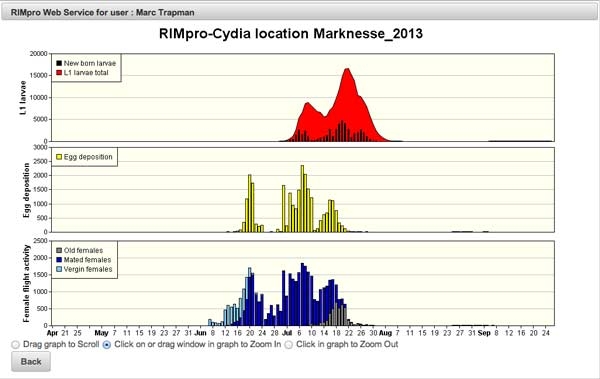Codling moth is a key pest in orchards. Commercial, integrated, or organic apple production is not possible without effective control of codling moth populations.
The available insecticides have different modes of action and not all of them are equally effective.
Accurate timing of insecticide treatments in relation to their mode of action and the local biology is crucial to achieve effective control with minimal residues and costs.
For Australia RIMpro service is offered by Marcel Veens Horticultural Adviser Pty.Ltd.
Key pest
Codling moth (Cydia pomonella) is a key pest almost everywhere apples are grown.
Even in the most northern production areas were the codling moth develops only a single generation per year, 10–50% of the crop can be destroyed.
Codling moth is highly specialized to attack apple and pear. While natural enemies have some effect on the population, under natural conditions codling moth populations—and damage—tend to increase from year to year.
At low population levels, management is not very problematic, but once 2–5% fruit damage is reached, control becomes increasingly difficult.
Biology
In spring, increasing day length awakens the codling moth from winter dormancy (diapause) and pupation begins.
In August (northern hemisphere), decreasing day length forces the larvae to enter winter diapause. Development during the months to follow will be dependent on temperature.
In the northern part of Europe the climate allows only one generation to develop, whereas in the very south it is warm enough to develop three generations.
Simple models
Models help us to find the best moments for treatments to control codling moth.
Simple models use temperature sums (degree days) higher than 10C. These provide a crude indication of the time when the first eggs are laid and expected to hatch.
However, this approach has several limitations that make it of limited use for practical decision-making. It is not the average temperature during the day, but instead, the weather conditions around sunset that determine if the moths fly and how many eggs are laid.
Moreover, we are not so much interested in the very first egg or larvae, but rather need to know how long egg-hatching continues and where the peaks in egg-hatching occur, which will help us guide and refine our treatments.
Modelling the population
The RIMpro-Cydia model simulates the evolution of an overwintering codling moth population during spring and summer.
From this we can easily determine the key times for our treatments.
The model uses all current knowledge on the responses of the insect to environmental conditions. These reactions are universal.
The local microclimate determines the local codling moth biology. When the model is run using weather data from the north of The Netherlands, we see that the codling moth could only develop a single generation in 2013 (Figure 1).
When we feed the same model data from South-East Austria we see that two complete codling moth generations could develop before the population entered diapause again (Figure 2).
On the sun-exposed side of the tree, eggs, larvae and pupae develop at different rates compared to the shady side. To account for this, the model calculates for sub-populations in different parts of the tree. The user won’t notice this as all results are merged in a single graph.
Interpreting the graphs
The bottom graph in Figures 1 and 2 shows the flight of the female moths. Juvenile unmated females are shown in light blue, mated females in dark blue, and females that have laid all their eggs in grey.
continued next issue
For information and to see the Figures, see Tree Fruit October 2014




















